摘要: 孤子是自然界中一种基本的非线性波动传递形式, 孤子间的相互作用能够映射出复杂非线性系统的多体动力学过程, 具有重要的基础研究价值. 被动锁模激光器是研究孤子相互作用的理想平台. 光孤子之间的吸引、排斥作用能够形成孤子分子, 而时间拉伸色散傅里叶变换(TS-DFT)技术使得实时探测孤子分子动力学成为可能. 基于TS-DFT技术, 本文实验研究了钛宝石飞秒激光器产生的孤子分子的内部动态, 通过改变抽运功率, 分别观察到了间隔为180 fs的稳定的孤子分子和间隔为105 fs的具有微弱相位振荡的孤子分子, 后者的振动幅度仅为0.05 rad. 实验发现受到环境影响, 稳定态的孤子分子还能够转变为相位滑动状态. 这些间隔为百飞秒量级的光学孤子分子对于研究孤子的近程非线性相互作用具有突出的意义.
关键词: 锁模 /
孤子分子 /
色散傅里叶变换 /
钛宝石激光器 English Abstract Internal dynamic detection of soliton molecules in Ti:sapphire femtosecond laser Zhou Feng # ,Cai Yu # ,Zou De-Feng Hu Ding-Tong Zhang Ya-Jing Song You-Jian Hu Ming-Lie Key Laboratory of Opto-electronic Information Technology, Ministry of Education, Ultrafast Laser Laboratory, School of Precision Instrument and Opto-electronics Engineering, Tianjin University, Tianjin 300072, China Received Date: 29 December 2019Accepted Date: 21 January 2020Published Online: 20 April 2020Abstract: Soliton is a universal format of nonlinear wave propagation in nature. Soliton can maintain its shape during propagation. This unique property has been widely observed in plasma physics, high energy electromagnetics, hydrodynamics, and nonlinear optics. Soliton interactions can reflect collective dynamic behaviors in complex nonlinear systems, showing significant basic research value. Passive mode-locked laser is an ideal platform for studying soliton interaction. The attraction and repulsion between two optical solitons can form soliton molecules. Their properties have been intensively studied by optical spectral analysis. However, conventional optical spectrum analyzers show low resolution and long average time. Time-stretched dispersive Fourier transformation (TS-DFT) is an emerging-powerful measurement technology, which can map the spectrum of an optical pulse to a temporal waveform under sufficient dispersion. The TS-DFT makes it possible to detect the dynamics of the solitons in real time. Based on TS-DFT, the internal dynamics of the solitons in Ti:sapphire femtosecond laser is studied in experiment. By changing the pump power, the stable soliton molecules with a separation of 180 fs and the weak phase oscillatory soliton molecules with a separation of 105 fs are observed. The amplitude in the weak oscillation state is merely 0.05 rad. We also find that the soliton molecules in stable state can transform into phase sliding state under environmental perturbation. These optical soliton molecules with a binding separation of 100 fs are of great significance for studying the short-range nonlinear interactions of solitons.Keywords: mode-locked /soliton molecules /dispersive Fourier transformation /Ti:sapphire laser 全文HTML --> --> --> 1.引 言 孤子是由于线性和非线性物理机制平衡后产生的一种局域化的波包, 能在长距离的传输中保持自身形状的稳定性, 这种特性展示了在长途光通信领域的广泛应用前景[1 ,2 ] . 将孤子的概念引入到耗散系统中, 发现通过对耗散孤子特性的深入研究有助于解决流体力学[3 ] 、玻色-爱因斯坦凝聚态[4 ] 、非线性光学[5 ] 等众多学科中复杂的非线性动力学机制. 被动锁模激光器凭借其谐振腔参数灵活可调、操作简单等优势被广泛用来研究复杂的孤子内部非线性动力学过程[6 -12 ] . 当多个耗散孤子在一个激光腔中共存时, 基于脉冲重叠的相干相互作用会产生相互作用力[13 ] , 并结合形成束缚态孤子. 相邻脉冲之间含有时间间隔和相位差这两个自由度. 从基础物理的角度出发, 这种结构可以类比于物质分子, 也叫作孤子分子(soliton molecule, SM).[14 -20 ] . TS-DFT利用一段能提供充足色散的长光纤, 将光谱信息映射到时域, 再通过高速光电探测器和实时示波器检测, 从而获得光谱的瞬态信息[21 ,22 ] . 这项技术使得研究孤子相互作用的瞬态动力学成为可能.[23 ] 理论推导预测了激光腔内两个孤子束缚态的存在. 2017年, Krupa等[24 ] 报道了光纤激光器内耗散SM内部相位振荡和滑动相位两种不同的相位脉动机制, 深化了SM与物质分子的类比. 2018年, Liu等[25 ] 利用TS-DFT技术实时观测了光纤激光器中SM建立的动力学过程, 主要包括弛豫振荡、拍频过程、瞬态单脉冲阶段、瞬态束缚态阶段和稳定束缚态阶段. 发现其建立过程对腔内光的偏振和抽运功率的变化十分敏感. 目前, 大部分的孤子分子动力学的研究都是在被动锁模光纤激光器内开展的. 钛宝石飞秒激光器能够输出10 fs级超短脉冲[26 -28 ] , 形成间隔百飞秒的紧束缚的SM[29 ] , 是光纤激光器不能实现的. 这种近程SM能够为孤子间相互作用力的研究提供一个新的视角, 尤其对于孤子的近程相互作用具有重要的研究价值. 早在1999年, Lederer等[30 ] 在加入可饱和吸收镜的钛宝石激光器内发现了多脉冲的现象. 2008年, Han等[31 ] 分析了抽运功率和克尔效应对钛宝石激光器内多脉冲现象的影响. 随着实时光谱探测技术的发展, 钛宝石飞秒激光器的孤子分子动力学逐渐引起了关注[32 ] . 近期, Kurtz等[33 ] 通过给抽运功率施加短时间的调制, 利用TS-DFT观察到不同时间间隔SM的全光可控.2.实验装置 本实验室自制的钛宝石激光器的结构为一个典型的Z型腔, 如图1 所示. 该激光器用532 nm的全固态Nd:YVO4激光器(Spectra-Physics, Millennia)抽运. 主要由厚度为2.3 mm、掺杂浓度为0.25 wt.%的钛蓝宝石晶体、两个$R = - 75\;{\rm{mm}}$ 的折叠球面镜(M1, M2)和两个不同长度的线性臂组成. 腔的两端分别为透射率为7%的平面镜输出耦合器(OC)和高反射率的平面镜(M4). 此外, 腔中的啁啾镜对(CM1, CM2)和熔融石英棱镜对(P1, P2) 用于补偿群速度色散, 加入平面镜M3折叠光路以减小激光器的尺寸. 在M1之前利用一个焦距为$f = 75\;{\rm{mm}}$ 的透镜, 将抽运光聚焦到晶体中. 由于钛宝石晶体以布鲁斯特切割, 输出的脉冲为P态偏振. 本激光器利用克尔透镜机制实现被动锁模, 在本实验中, 端镜M4被固定在可推动的光学调整架上, 推动调整架启动锁模.图 1 基于钛宝石激光器的TS-DFT实验装置图 (OC, 输出耦合镜; P, 棱镜对; CM, 啁啾镜对; L, 透镜; Ti:S, 钛宝石晶体; M, 平面镜; FC, 光纤耦合器; SMF, 单模光纤; PD, 光电探测器; OSC, 高速示波器)Figure1. TS-DFT experimental setup based on Ti: sapphire laser (OC, output coupler; P, prim; CM, chirped mirror; L, lens; Ti:S, Ti:sapphire; M, mirror; FC, fiber coupler; SMF, single-mode fiber; PD, photodetecter; OSC, high-speed oscilloscope).$\beta = {\rm{4}} \times {\rm{1}}{0^{{{ - 2}}}}\;{\rm{p}}{{\rm{s}}^{\rm{2}}}/{\rm{km}}$ . 经过单模光纤展宽的脉冲由一个带宽为12.5 GHz的高速响应光电二极管(Newport 818-BB-45F)进行光电转换, 利用一台带宽为8 G的实时示波器(R&S?RTP)测量实时光谱.3.实验结果与分析 当抽运功率达到2.8 W时, 可以观察到稳定的120 MHz基频锁模脉冲, 激光器在以800 nm为中心波长的40 nm半高宽的孤子锁模域工作. 当抽运功率进一步增加到3.3 W时, 通过微调棱镜P1的插入量可以实现束缚态锁模. 高速示波器以10 μs的时间窗口记录了120 MHz重复频率的锁模脉冲序列, 相应的实时光谱的更新周期T rep 为8.3 ns, 将时间序列分割成长度为T rep 的区间, 得到一个1200个连续的实时光谱. 图2(a) 的时间序列图展示了SM的实时光谱演化图样, 横轴代表波长, 纵轴代表孤子在腔内循环的圈数. 图中平稳的条纹表明两个脉冲之间具有稳定的时间间隔. 把每一个往返的光谱图做傅里叶变换能得到对应的自相关曲线, 如图2(b) 所示, 从而直观地看到两个孤子的间隔$\tau = 105\;{\rm{fs}}$ . 图2(c) 是SM的相对相位演化图, 相对相位的振幅为0.05 rad, 不同于以前研究中报道的强相位振荡(${3{\text{π}}} /2$ rad或更强)[24 ,29 ] , TS-DFT的光谱干涉条纹并没有发生扭曲.图 2 实时观察105 fs时间间隔孤子分子参数图 (a) 孤子分子的光谱演化图样和对应的单帧光谱图; (b) 自相关的演化图和对应的单帧自相关曲线; (c) 相对相位演化图; (d) 光谱仪与DFT测到的光谱对比图Figure2. Experimental real-time observation soliton molecules with a separation of 105 fs: (a) Interferograms of a soliton bound state and its single-shot spectrum; (b) the field autocorrelations of the momentary bound state; (c) relative phase evolution diagram; (d) optical spectrum measured by OSA and DFT.D 和L 分别是色散参数和单模光纤长度, $\Delta \lambda $ 是光谱的带宽, $\Delta t$ 是光谱映射到时域的相应时间. 这个公式也被称为鞍点近似, 体现出了色散对映射关系的影响. 为了验证本实验中时域对频域正确的映射, 我们把示波器测量的光谱的时间信息用(1 )式变换到频域, 并与光栅光谱仪测量到的平均光谱信息对比, 绘制出图2(d) . 实线代表光谱仪测量出的平均光谱, 两种虚线分别代表用TS-DFT测出的第1次和第100次腔往返的实时光谱图. 图中光谱仪测得的SM光谱周期与TS-DFT记录的光谱周期完全一致, 光谱形状的轻微差异可能与TS-DFT所使用的展宽光纤的高阶色散、非线性有关[22 ,24 ] .τ 与光谱调制周期$\Delta \alpha $ 的表达式:c 为光速, λ 为中心波长. 本实验中λ 为800 nm, $\Delta \alpha $ 为20 nm, 计算出时间间隔$\tau = 105\;{\rm{fs}}$ , 与图2(b) 中的脉冲间隔一致. 实验结果符合理论预测, 证实了实验数据的合理性.图3(a) —图3(d) 所示. 此时, 从图3(a) 的干涉图样或图3(d) 的光谱中可以看到, 当时间间隔增大时, 干涉峰的数量增多, 干涉条纹的调制周期(12 nm)变窄. 这一关系可在(2 )式上体现. 结合脉冲间隔τ 和相对相位Φ 的信息, 说明此时SM受到腔中吸引子的作用, 两个孤子以稳定的自组装形式在腔内传播.图 3 实时观察180 fs时间间隔孤子分子数据图 (a) 孤子分子的光谱演化图; (b)自相关演化图; (c)相对相位演化图; (d)光谱仪与DFT测到的光谱对比图Figure3. Experimental real-time observation stable soliton molecules with a separate of 180 fs: (a) Interferograms of a soliton bound state; (b) the field autocorrelations of the momentary bound state; (c) relative phase evolution diagram; (d) optical spectra measured by OSA and DFT.[32 ] , 并在实验上被观察到, 不同的是一般通过降低抽运功率得到这种状态. 绘制出相应的光谱演化图, 如图4(a) 所示, 随着SM在腔内的往返, 干涉图的强度呈现出向长波明显的滑移, 反映出SM的内部不稳定性. 图4(b) 为对应的自相关演化图, 两个孤子的脉宽产生微小震荡. 在图4(c) 中, 脉冲间的相位差持续增大, 这可以归因于形成SM的两个脉冲强度不相等. 产生这种现象的原因是钛宝石激光器受到环境因素的干扰, 孤子相互之间产生复杂的能量交换. 导致SM中尾部的脉冲强度大于前部的脉冲, 前后脉冲的相速度差为正, 从而使相位差增大. 当然环境因素的变化还需要更多的实验研究和理论推导. 图4(d) 的光谱图并没有像前面一样完全一致, 是因为处于这种状态的SM的光谱在每一次腔往返过程中都会变化.图 4 滑动相位孤子分子数据图 (a) 光谱演化图; (b) 自相关演化图; (c) 相对相位演化图; (d)光谱仪与DFT测到的光谱对比图Figure4. Experimental real-time observation soliton molecules with a sliding phase: (a) Interferograms of a soliton bound state; (b) the field autocorrelations of the momentary bound state; (c) relative phase evolution diagram; (d) optical spectra measured by OSA and DFT.图5 所示, 其中半径τ 代表SM的时间间隔, 角度φ 代表相对相位, z 轴为脉冲在腔内的往返圈数. 左图中的轨迹展示了孤子在1200个腔往返周期内的动态演化过程. 图中的区域①和②分别为观测到的105 和180 fs脉冲间隔的SM, 右侧的两幅图对区域①和②进行放大. ①图表示的105 fs间隔的孤子分子呈现出明显的相位振荡现象. ②图描述的是180 fs脉冲间隔的稳定SM, 它的脉冲间隔不变, 相对相位有微小的波动, 这个波动是TS-DFT系统以及数据处理过程中的噪声引起的. 图中螺旋演化的圆环③代表相位滑动SM, 它的脉冲间隔保持稳定, 相对相位随着脉冲的演化连续地增加. 在第1000次腔往返附近的圆环上出现了3个点, 表示相位滑动SM演化过程中由于内部不稳定产生的3次脉冲间隔的跳变. 从物理本质上讲, ①和②对应于非线性系统的不动点吸引子, 而③对应于极限环吸引子; 外界环境的干扰促使②转化为③, 即产生霍夫型分岔.图 5 孤子分子的动态互作用平面Figure5. Dynamics of the SM mapped into the interaction plane.4.结 论 利用TS-DFT技术, 实时地观测了钛宝石激光器内SM的内部动态. 通过改变抽运功率和腔内色散, 可重复产生具有不同时间间隔的稳定态SM. 实验首次发现钛宝石激光器内幅度仅为0.05 rad的弱相位震荡的SM. 同时, 实验中也观察到环境扰动能够使稳定的SM过渡到相位滑动特性的振动SM. 这些实验现象为研究近程SM的相互作用提供了更多的依据, 对于改善固体激光器性能和研究其内部的非线性动力学具有参考价值. 

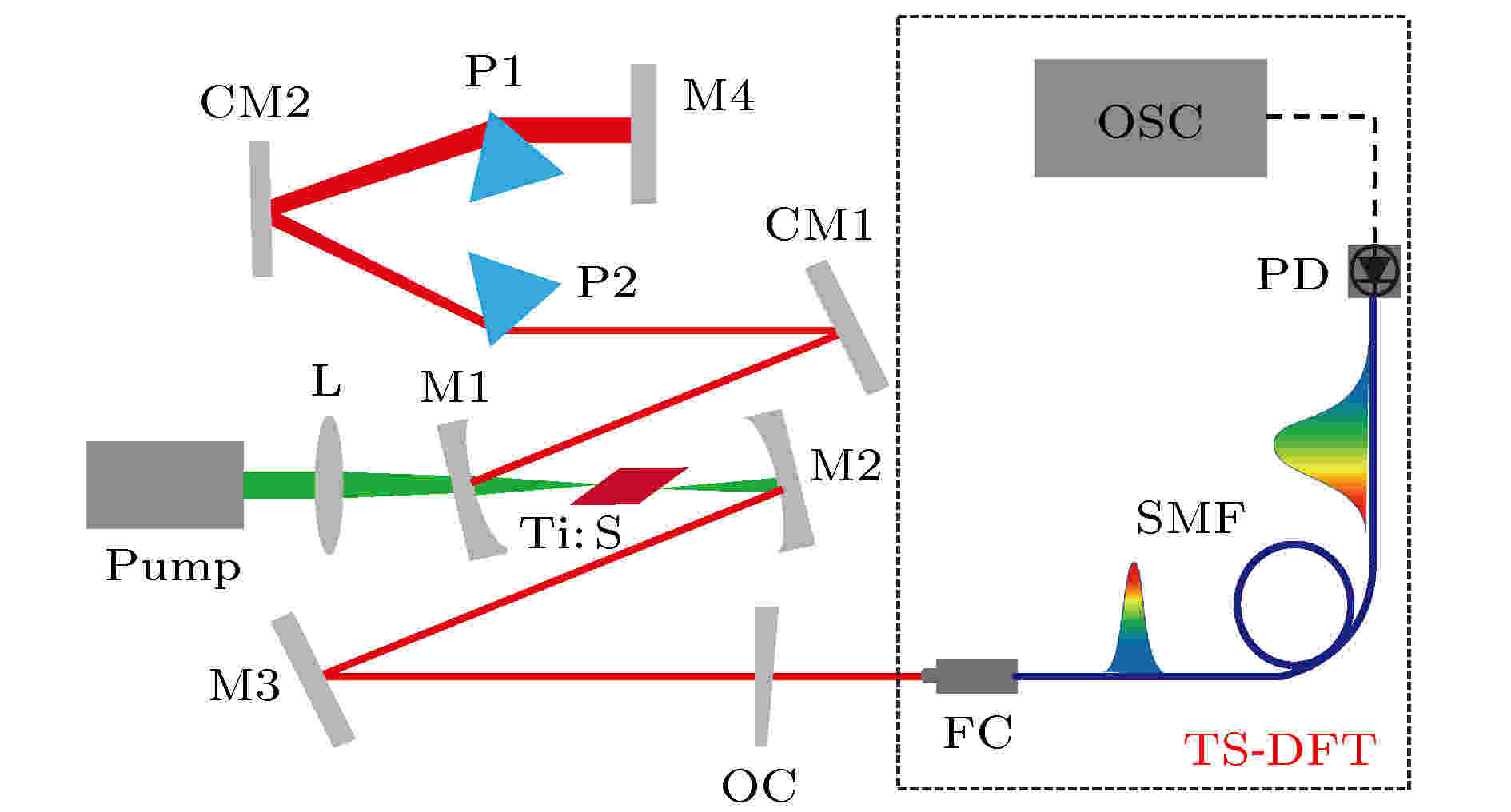 图 1 基于钛宝石激光器的TS-DFT实验装置图 (OC, 输出耦合镜; P, 棱镜对; CM, 啁啾镜对; L, 透镜; Ti:S, 钛宝石晶体; M, 平面镜; FC, 光纤耦合器; SMF, 单模光纤; PD, 光电探测器; OSC, 高速示波器)
图 1 基于钛宝石激光器的TS-DFT实验装置图 (OC, 输出耦合镜; P, 棱镜对; CM, 啁啾镜对; L, 透镜; Ti:S, 钛宝石晶体; M, 平面镜; FC, 光纤耦合器; SMF, 单模光纤; PD, 光电探测器; OSC, 高速示波器)


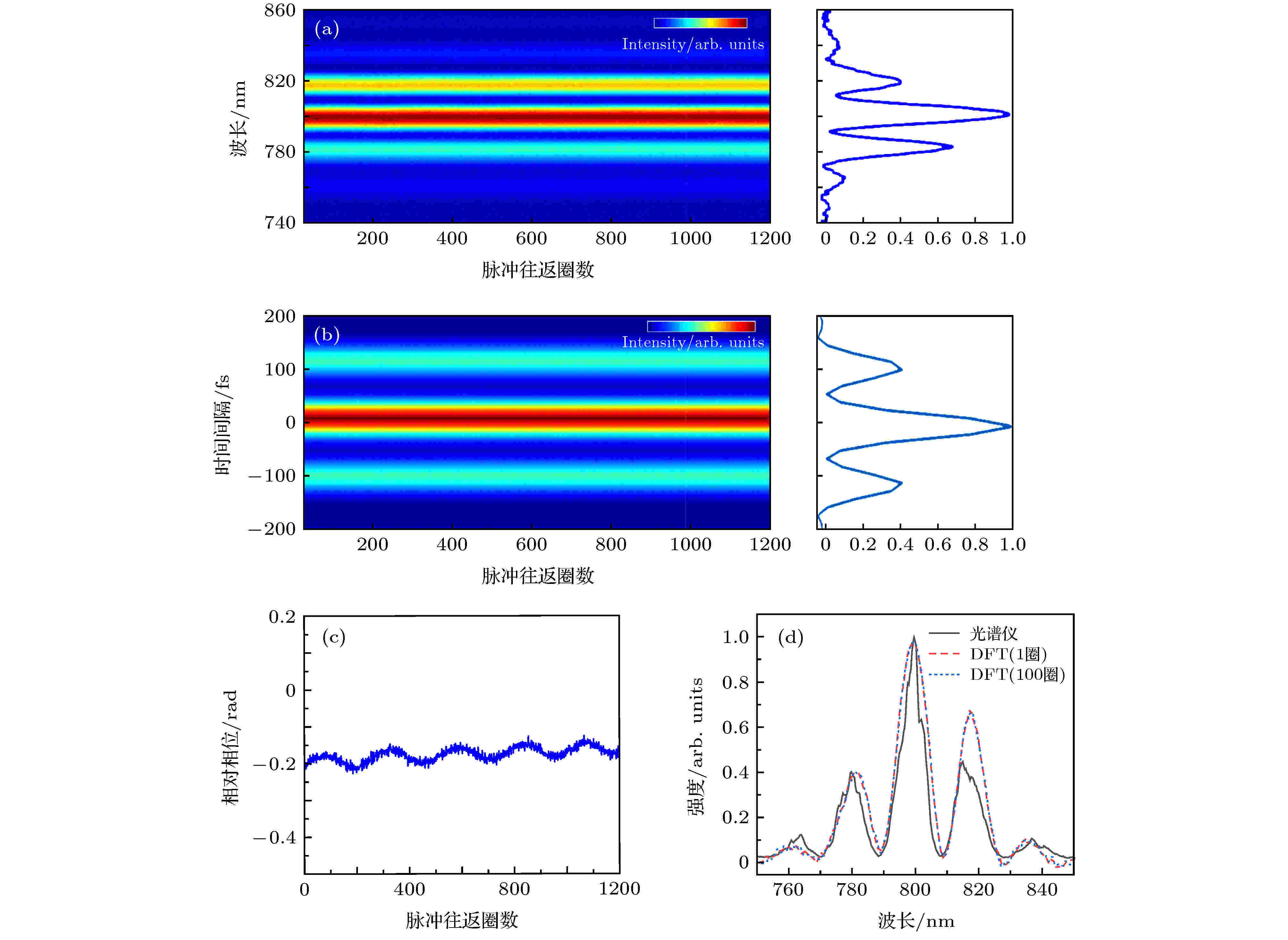 图 2 实时观察105 fs时间间隔孤子分子参数图 (a) 孤子分子的光谱演化图样和对应的单帧光谱图; (b) 自相关的演化图和对应的单帧自相关曲线; (c) 相对相位演化图; (d) 光谱仪与DFT测到的光谱对比图
图 2 实时观察105 fs时间间隔孤子分子参数图 (a) 孤子分子的光谱演化图样和对应的单帧光谱图; (b) 自相关的演化图和对应的单帧自相关曲线; (c) 相对相位演化图; (d) 光谱仪与DFT测到的光谱对比图




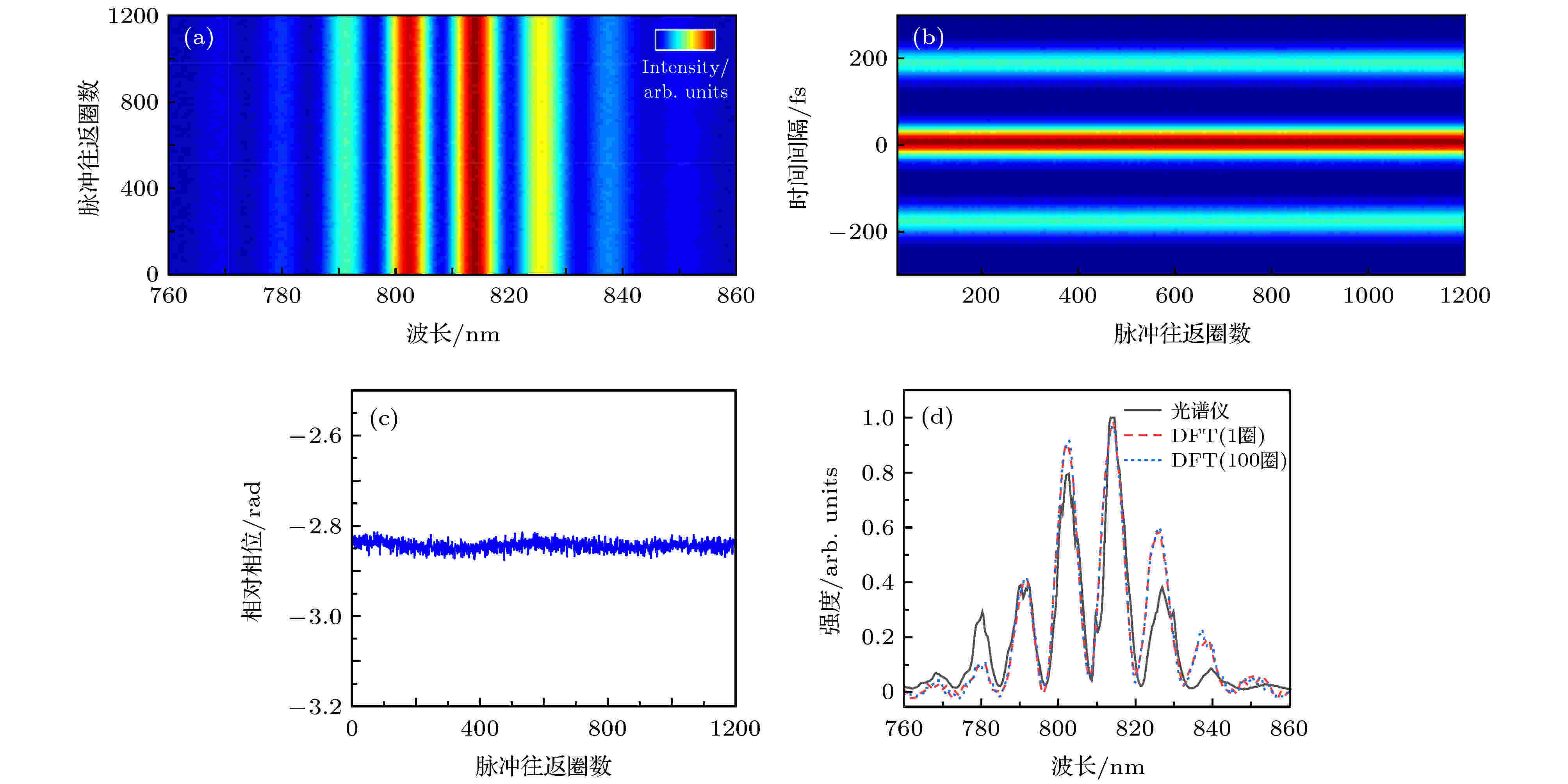 图 3 实时观察180 fs时间间隔孤子分子数据图 (a) 孤子分子的光谱演化图; (b)自相关演化图; (c)相对相位演化图; (d)光谱仪与DFT测到的光谱对比图
图 3 实时观察180 fs时间间隔孤子分子数据图 (a) 孤子分子的光谱演化图; (b)自相关演化图; (c)相对相位演化图; (d)光谱仪与DFT测到的光谱对比图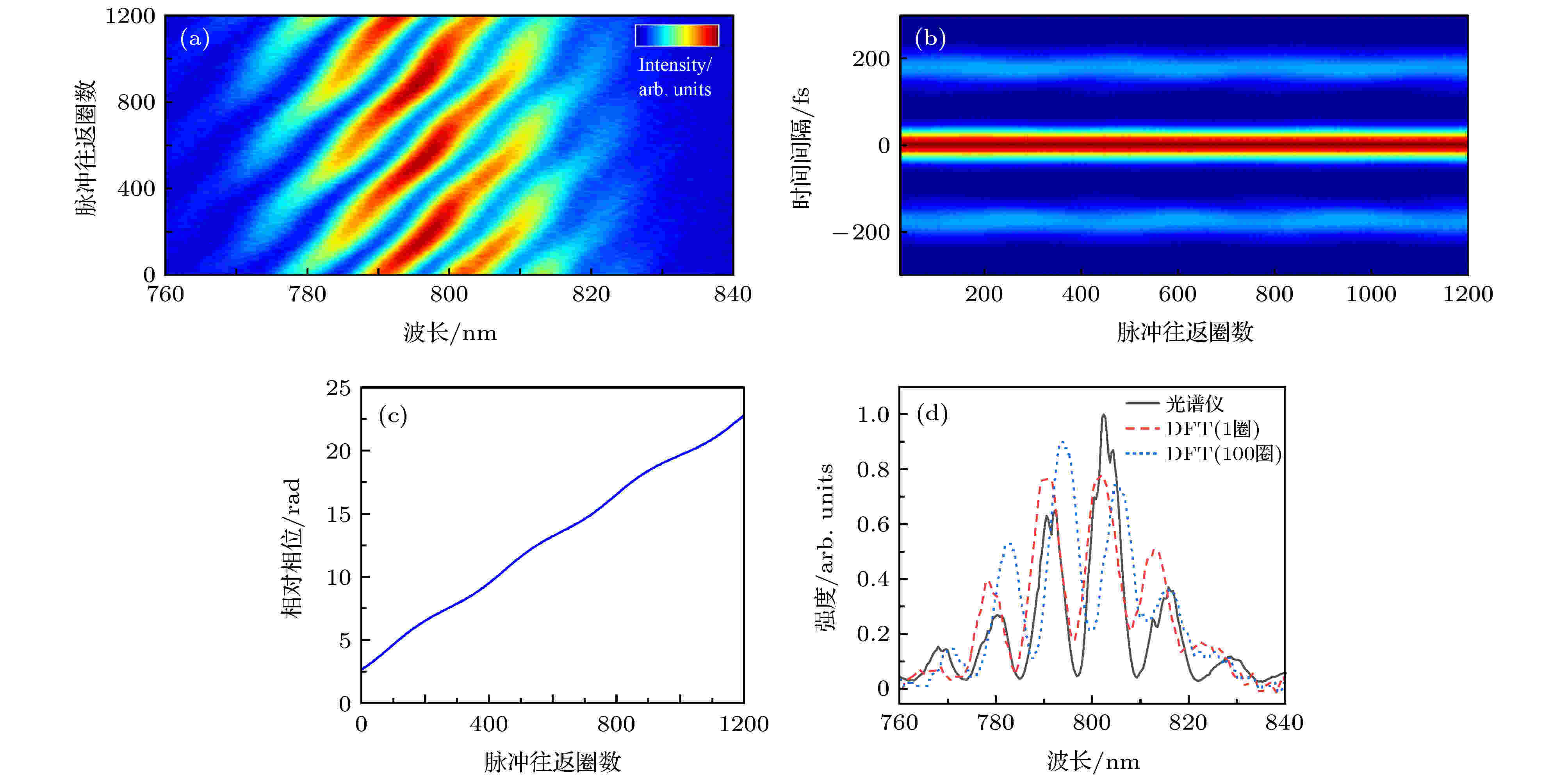 图 4 滑动相位孤子分子数据图 (a) 光谱演化图; (b) 自相关演化图; (c) 相对相位演化图; (d)光谱仪与DFT测到的光谱对比图
图 4 滑动相位孤子分子数据图 (a) 光谱演化图; (b) 自相关演化图; (c) 相对相位演化图; (d)光谱仪与DFT测到的光谱对比图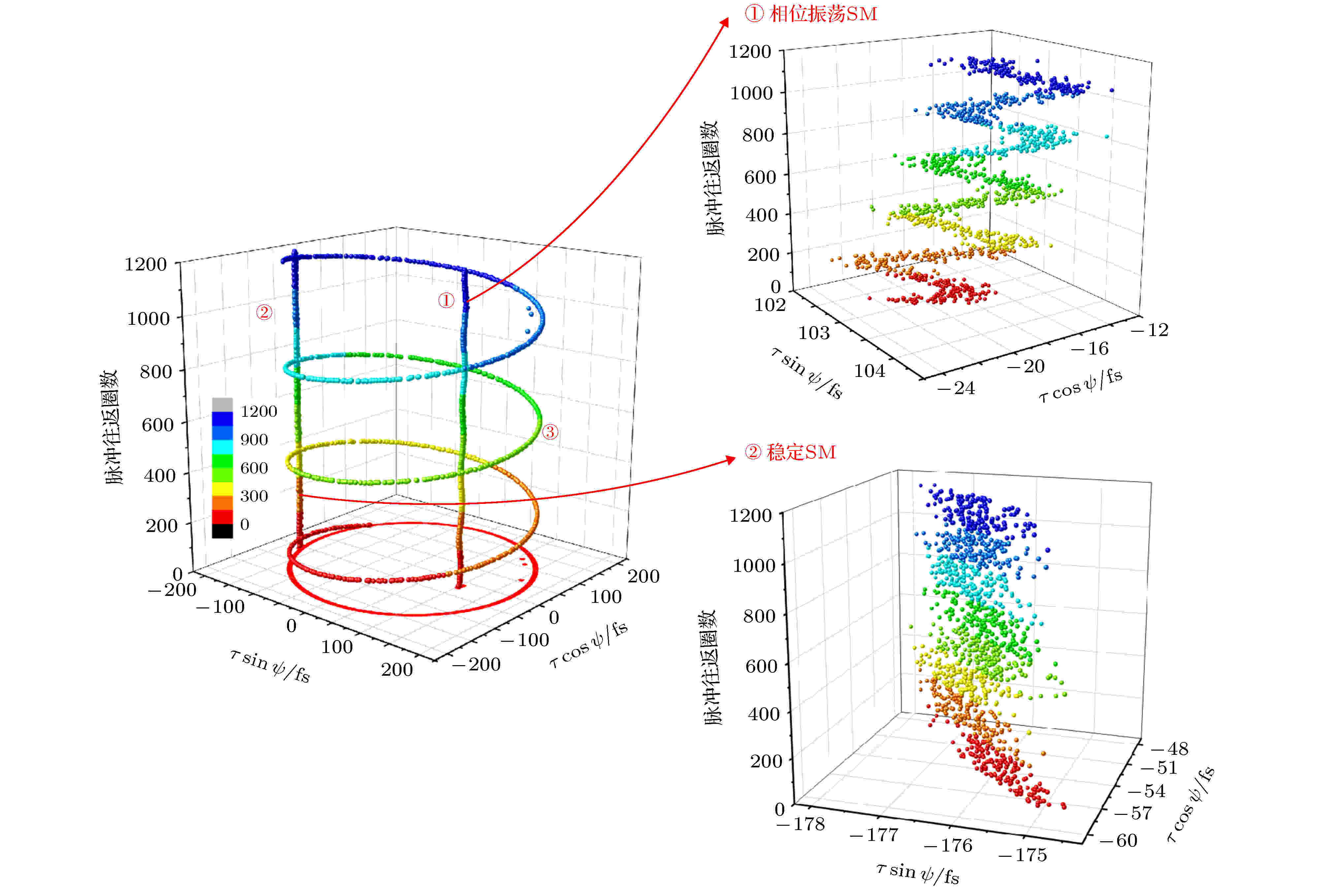 图 5 孤子分子的动态互作用平面
图 5 孤子分子的动态互作用平面